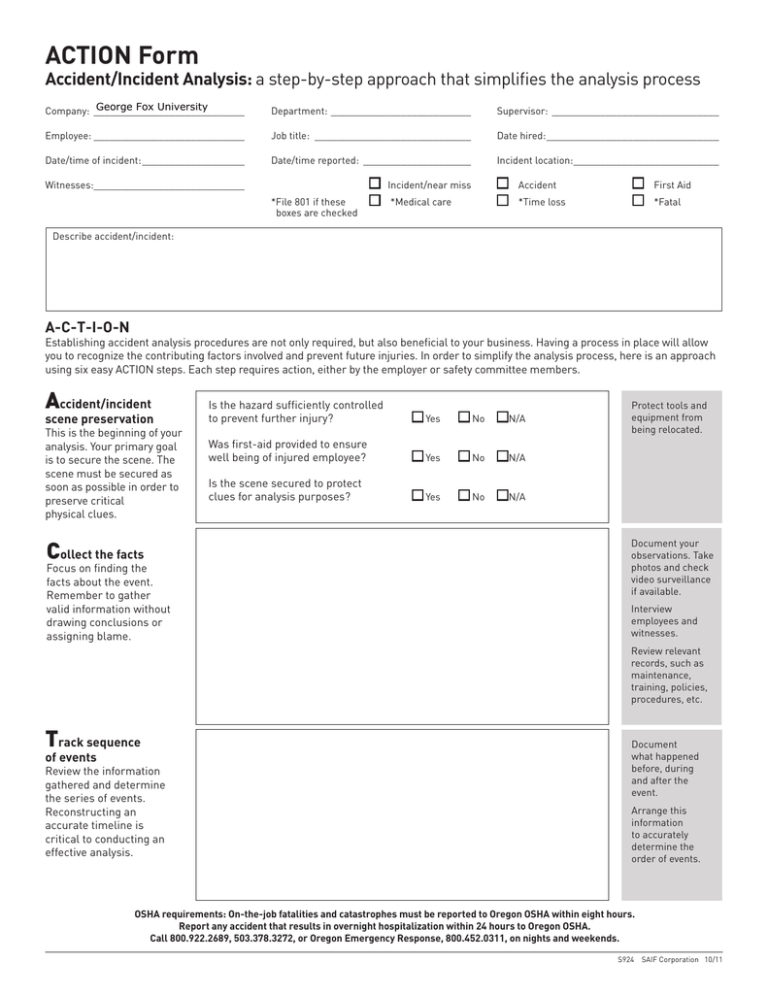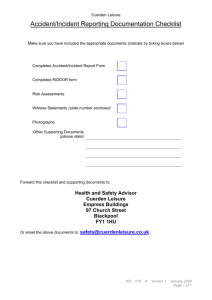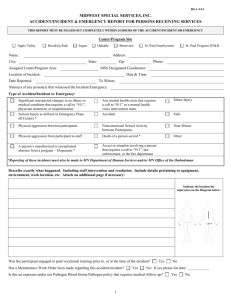ACTION Form Accident/Incident Analysis:
advertisement

ACTION Form Accident/Incident Analysis: a step-by-step approach that simplifies the analysis process George Fox University Company:_ ____________________________ Department:___________________________ Supervisor:_ _______________________________ Employee:_____________________________ Job title:_ _____________________________ Date hired:_________________________________ Date/time of incident:____________________ Date/time reported:_ ____________________ Incident location:____________________________ Witnesses:_____________________________ Incident/near miss Accident First Aid *Medical care *Time loss *Fatal *File 801 if these boxes are checked Describe accident/incident: A-C-T-I-O-N Establishing accident analysis procedures are not only required, but also beneficial to your business. Having a process in place will allow you to recognize the contributing factors involved and prevent future injuries. In order to simplify the analysis process, here is an approach using six easy ACTION steps. Each step requires action, either by the employer or safety committee members. Accident/incident scene preservation This is the beginning of your analysis. Your primary goal is to secure the scene. The scene must be secured as soon as possible in order to preserve critical physical clues. Collect the facts Focus on finding the facts about the event. Remember to gather valid information without drawing conclusions or assigning blame. Is the hazard sufficiently controlled to prevent further injury? Yes No N/A Was first-aid provided to ensure well being of injured employee? Yes No N/A Is the scene secured to protect clues for analysis purposes? Yes No N/A Protect tools and equipment from being relocated. Document your observations. Take photos and check video surveillance if available. Interview employees and witnesses. Review relevant records, such as maintenance, training, policies, procedures, etc. Track sequence of events Review the information gathered and determine the series of events. Reconstructing an accurate timeline is critical to conducting an effective analysis. Document what happened before, during and after the event. Arrange this information to accurately determine the order of events. OSHA requirements: On-the-job fatalities and catastrophes must be reported to Oregon OSHA within eight hours. Report any accident that results in overnight hospitalization within 24 hours to Oregon OSHA. Call 800.922.2689, 503.378.3272, or Oregon Emergency Response, 800.452.0311, on nights and weekends. S924 SAIF Corporation 10/11 Contributing factors example Employee slipped and fell in the hallway WHY Water on the floor WHY Leaking water cooler, water wasn’t cleaned up Drain was plugged, machine wasn’t serviced WHY WHY No formal written maintenance schedule Surface causes Use the diagram above as an example. contributing factors Every accident/incident is caused by a set of contributing factors. These factors represent the surface or root causes that led to the event. The goal is to identify these by analyzing how/why each consecutive event happened. Surface cause: unsafe behaviors and hazardous conditions. Root cause: underlying problems with policies/ procedures. Engineering controls: Management controls: Use guarding, less hazardous material or a different design to remove/reduce the hazard. Personal protective equipment (PPE): Use work practices, scheduling, or job rotations to remove/ reduce the exposure. possible solutions Once the surface and root causes have been determined, you are ready to identify possible solutions. These should be prioritized based on their level of effectiveness. Remember to list multiple solutions. Note corrective measures The last ACTION step is to use your notes from the steps above to complete this form. No management review of systems/policies Root cause Identify Organize WHY Place a barrier, such as safety glasses, gloves, ear plugs, between employee and hazard. Your recommendations should be relevant and concise. Identify who will be responsible for completing the action items on your list. How will you correct the issues addressed in the boxes above? Supervisor/prepared by:___________________________________ Employee:______________________________________________ Report your findings to members of management who have the authority to act. Date:_________________ Date:_________________ Remember to keep accident reports on file for record keeping purposes. Person assigned: Completion date: Copy: Safety Committee, Management Team, Owner/President This is only an accident/incident analysis form. You will need to complete the workers’ compensation clam form (801) if the injury required medical treatment beyond first aid. There are also other Oregon record keeping requirements for recording and reporting work-related fatalities, injuries, and illnesses. Please reference http://www.orosha.org/subjects/recordkeeping.html for additional information on these requirements. S924 SAIF Corporation 10/11



